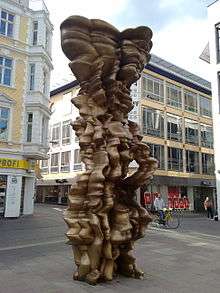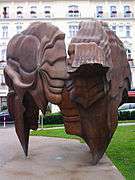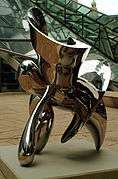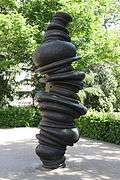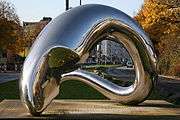Anthony Douglas Cragg, CBE RA (born 9 April 1949) is a British sculptor.

Ferryman Bronze, 1997

Blood Sugar, by Tony Cragg, is on display in the Corning Museum of Glass (2015). The piece was made in Germany, Wuppertal, 1992.
Early life and training
Tony Cragg was born in Liverpool[1] on 9 April 1949.[2] Between 1966 and 1968 he worked as a lab technician for the National Rubber Producers' Research Association. In 1969 he enrolled in the foundation course at Gloucestershire College of Art and Design in Cheltenham, Gloucestershire. He studied at Wimbledon School of Art from 1970 to 1973, and then until 1977 at the Royal College of Art.[3] Cragg moved to Wuppertal, in North Rhine-Westphalia in western Germany in 1977, and in 1978 began teaching at the Kunstakademie of Düsseldorf.[3]
Career
Tony Cragg’s early work involved site-specific installations of found objects and discarded materials.[4] From the mid-1970s through to the early-1980s he presented assemblages in primary structures (as in his first mature piece, the 1975 Stack)[4] as well as in colourful, representational reliefs on the floors and walls of gallery spaces (as in Red Indian of 1982-3).[5] Cragg constructed these early works by systematically arranging individual fragments of mixed materials, often according to their artificial colours and profiles, so as to form larger images.[6]
Britain Seen from the North (1981) is a signature early work, made of multi-coloured scraps of various materials assembled in relief on the wall. The piece depicts the outline of the island of Great Britain, orientated sideways so that Northern Britain is positioned to the left.[7] The island is scrutinized by a figure, representing Cragg himself, who looks at his native country from the position of an outsider. Britain Seen from the North (1981) is often interpreted as commenting on the social and economic difficulties that Britain was facing under ‘Thatcherism’, which had particular effect in the north.[6] This work was first exhibited in the large upstairs space at the Whitechapel Art gallery in London in 1981 and is now in the Tate collection.[8]
After moving to Germany in the late 1977 Cragg had several solo exhibitions including Lisson Gallery, London (1979);[9] Lützozstr. Situation, Berlin (1979) and Künstlerhaus Weidenallee, Hamburg (1979).[10] He also exhibited in seminal group shows including the Silver Jubilee Sculpture Show, Battersea Park, London (1977); Europa-Kunst der 80er Jahre, Stuttgart (1979); Kunst in Europa na ’68, Museum van Hedendaagse Kunst, Gent (1980) and L’art degli anni Settanta/Aperto ’80, Venice Biennale (1980).[11]
In the early-1980s Cragg gradually moved away from installation art and began to examine more closely the individual objects used as parts of his larger constellations.[4] This was the beginning of his engagement and experimentation with the properties and possibilities of a wide range of more permanent materials in the form of wood, plaster, stone, fiberglass, Kevlar, stainless steel, cast iron and bronze.[12] In the early 1980s Cragg exhibited at Arnolfini Gallery, Bristol (1980);[13] Whitechapel Art Gallery, London (1980);[14] Von der Heydt-Museum, Wuppertal (1981);[15] Institute of Contemporary Art, London (1982);[16] Documenta 7, Kassel (1982) and the Hayward and Serpentine Galleries, London (1983).[17] Since then Cragg has exhibited extensively at many of world’s most important art institutions.[18] By the end of the decade Cragg received the Turner Price at the Tate Gallery in London (1988), represented Britain at the 42. Venice Biennale (1988)[19] and was appointed Professor at the Kunstakademie Düsseldorf (1988-2001).[11]
Throughout the 1990s Cragg continued to develop two larger groups of work that have sustained his production up to the present: the Early Forms and the Rational Beings.[4] The Early Forms series investigate the possibilities of manipulating everyday, familiar containers[20] and the ways in which they can morph into and around one another in space.[21] These sculptures derive their profiles and contours from simple, tick-walled vessels[20] – such as chemistry vessels, plastic bottles and mortars.[22] The surfaces of these initial objects are extended and contorted until new, sculpturally independent forms of movement arise. Through these processes of manipulation the initial objects develop new lines and contours, positive and negatively curving surfaces and volumes, protrusions and deep recessing folds.[21] The broad field of containers and vessels used function as metaphors for cell, organ, organism or body.[23] The Early Forms can be characterized as forms transmutating along a bilaterally curved axis, often with organic, even figurative, qualities. The Rational Beings are describable as organic looking forms often made of carbon fibre on a core of polystyrene.[22] These sculptures derive their forms from the contours of gestural drawings, which Cragg then translates into the third dimension using thick, circular or oval discs[24] which are superimposed (often vertically), glued together and covered with a skin.[25] The underlying structure of these sculptures gives their skin the tension of a membrane, reflecting the basic structures of many organisms, organs, plants and animals.
In the early 1990s, Cragg was awarded the Chevalier des Arts Lettres (1992) and appointed Royal Academician in London (1994).[26] During this decade of his career he exhibited at the 45. Venice Biennale (1993); The National Gallery, Prague (1995); MNAM, Centre Georges Pompidou, Paris (1996); MACBA, Barcelona (1997) and the Royal Academy, London (1999).[27] In the early 2000s Cragg was awarded the Shakespeare Prize (2001) and the Piepenbrock Prize for Sculptures (2002).[28] He was appointed Commander of the British Empire (CBE) (2002), Honorary Doctor of the Royal College of Art, London (2009), Professor at the Universitüt der Künste, Berlin (2001-2006), and began a Professorship at the Kunstakademie Düsseldorf (2006).[29] Among many major solo shows, Cragg exhibited at Tate Gallery Liverpool (2000); MACRO Museum of Contemporary Art, Rome (2003); and The Central House of Artists, Moscow (2005).[30] Since 2010, Cragg has been appointed Honorary Fellow of University of the Arts London (2012); awarded Artist’s Medal of Honor of the Hermitage, Russia (2012) as well as the 1st Class Order of Merit of the Federal Republic of Germany (2012).[31] He has exhibited at the Musée du Louvre in Paris (2011), the Scottish National Gallery in Edinburgh (2011) and at CAFA Museum in Beijing (2012).[32] Amongst new developments in Cragg’s work is an increase in sculptures that can be exhibited outdoors; more works wrought from bronze, steel, stone, wood and glass; as well as a vigorous return to his initial interest in art – that of drawing.[33]
Recognition
Cragg was selected to represent Britain at the 43rd Venice Biennale in 1988, and won the Turner Prize in the same year. In 2001 he received the now discontinued Shakespeare Prize of the Alfred Toepfer Foundation of Hamburg.[34] He was made a CBE for services to art in the 2002 New Year Honours List,[35] and also won the Piepenbrock Prize for Sculpture in that year.[36][37] In 2007 he received the Praemium Imperiale for sculpture of the Imperial House of Japan for the Japan Art Association.[2]
| Caldera (2008), in the Makartplatz, Salzburg, Austria |
| Wirbelsäule - the articulated column, in Viersen |
|
See also
References
- ↑ James Hall (22 July 2011). Tony Cragg and the sculpture wars. The Guardian. Accessed October 2014.
- 1 2 Anthony Douglas (Tony) CRAGG. Debrett's. Accessed October 2014.
- 1 2 Tony Cragg RA. Royal Academy of Arts. Accessed October 2014.
- 1 2 3 4 "Edinburgh Festival 2011: Tony Cragg interview". The Telegraph. 2011-07-29. Retrieved 2014-10-30.
- ↑ "Edinburgh Festival 2011: Tony Cragg, Scottish National Gallery". The Telegraph. 2011-08-09. Retrieved 2014-10-30.
- 1 2 "Tony Cragg: Sculptor who looks beneath the surface". The Telegraph. 2012-08-28. Retrieved 2014-10-30.
- ↑ http://www.tate.org.uk/art/artworks/cragg-britain-seen-from-the-north-t03347.
- ↑ Schimmel, Paul (1991). ‘‘Tony Cragg: Sculpture 1975 - 1990, p.48. Thames and Hudson.
- ↑ Winter, Simon Vaughan (1979). “Tony Cragg at Lisson”. Artscribe, no. 17.
- ↑ Cragg, Tony (2000). ‘‘Tony Cragg: a new thing breathing’’, p.156. Tate Publishing.
- 1 2 Lotz, Antonia (2012). ‘‘Tony Cragg Matrix’’, p. 16. NORD/LB art gallery and kestnergesellscaft, Hannover.
- ↑ "Tony Cragg and the sculpture wars". The Guardian. 2011-07-22. Retrieved 2014-10-30.
- ↑ Cragg, Tony (1980). “Tony Cragg”. Arnolfini Review, Bristol.
- ↑ Cooke, Lynne (1981). “Tony Cragg at the Whitechapel”. Artscribe, No. 28.
- ↑ Peters, Ursula (1981). “Materialien und Wahrnehmung: ein Zusammenspiel”. Von der Heydt Museum, Wuppertal.
- ↑ Naime, Sandy and Nicholas Serota (1982). “Symbols, Presences and Poetry”. Sculpture in the Twentieth Century, Whitechapel Art Gallery, London.
- ↑ Cragg, Tony (1985). ‘‘Tony Cragg’’, p.102. Societe Des Expositions Des Beaux Arts / Musee d’Art Moderne, Brussels and Paris.
- ↑ Cragg, Tony (1992). “Tony Cragg’’. Van Abbemuseum, Eindoven, Amsterdam.
- ↑ Cooke, Lynne (1988). “Venice Biennale”, Art International.
- 1 2 Cragg, Tony and Melitta Kliege (2005). ‘‘Tony Cragg - familiae’’, p.51. Nürnberg: Verlag für Modern Kunst.
- 1 2 Cragg, Tony (1999). ‘‘Tony Cragg: New Works’’. Royal Academy of Arts, London.
- 1 2 Cragg, Tony (2006). ‘‘Tony Cragg: In and Out of Material’’, p 203. Walther König, Köln.
- ↑ Cragg, Tony (2006). ‘‘Tony Cragg: In and Out of Material’’, p.189. Walther König, Köln.
- ↑ Cragg, Tony and Melitta Kliege (2005). ‘‘Tony Cragg - familiae’’, p.52. Nürnberg: Verlag für Modern Kunst.
- ↑ Cragg, Tony (1998). ‘‘Anthony Cragg: Material – Objekt – Form’’, p.83. Städtische Galerie im Lenbachhaus, Munich.
- ↑ Cragg, Tony and Melitta Kliege (2005). ‘‘Tony Cragg - familiae’’, p.51. Nürnberg: Verlag für Modern Kunst.
- ↑ Lotz, Antonia (2012). ‘‘Tony Cragg Matrix’’, p. 16. NORD/LB art gallery and kestnergesellscaft, Hannover.
- ↑ Lotz, Antonia (2012). ‘‘Tony Cragg Matrix’’, p.16. NORD/LB art gallery and kestnergesellscaft, Hannover.
- ↑ Cragg, Tony (2006). ‘‘Tony Cragg: In and Out of Material’’, p 203. Walther König, Köln.
- ↑ Ehmann, Arne and Lóránd Hegyi (2013). “Tony Cragg: [exposition, Musée d’Art Moderne de Saint-Etienne Métropole, 14 sept. 2013 – 5 janv. 2014]’’, p.148. Galerie Thaddaeus Ropac, Paris.
- ↑ Voigt, Kirsten Claudia and Christina Lichenstern, etc. (2009). “Tony Cragg: Second Nature”. DuMont Literatur und Kunst Verlag GmbH & Co KG.
- ↑ Cragg, Tony (2013). “Tony Cragg: Sculptures and Drawings’’, p.280. National Taiwan Museum of Fine Arts.
- ↑ Hudson, Mark (2012). ‘Sculptor who looks beneath the surface’, p.22 “The Daily Telegraph”, UK, 28 August 2012.
- ↑ Shakespeare-Preis; und ein Shakespeare-Studienstipendium (in German). Alfred Toepfer Foundation. Archived 19 June 2002.
- ↑ [s.n.] (31 December 2001). Honours shared across England. BBC News. Accessed October 2014.
- ↑ Robert Ayers (10 May 2007). Tony Cragg. ArtInfo. Archived 6 September 2008.
- ↑ [s.n.] (28 August 2002). Piepenbrock Preis: Anthony Cragg ist Meister der Skulptur (in German). Spiegel-Online. Accessed October 2014.
External links
